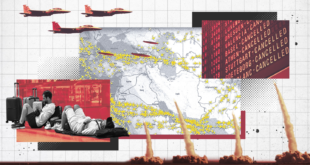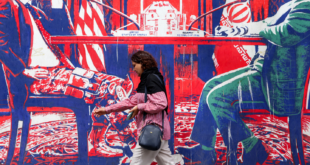 TEHRAN (FNA)- For 30 years, Parviz Tanavoli led a quiet life teaching sculpture and holding shows in his native Iran and abroad. That changed in April when a work sold for a record $2.84 million at an auction in Dubai.
TEHRAN (FNA)- For 30 years, Parviz Tanavoli led a quiet life teaching sculpture and holding shows in his native Iran and abroad. That changed in April when a work sold for a record $2.84 million at an auction in Dubai.
“The phone started ringing a few hours after that,” said Tanavoli, 70, in an interview in his studio in northern Tehran. “I’m getting upset with buyers. This is not a coin shop. I have a limited number of works.”
To stop the flood of offers to buy his sculptures, he unplugged his phone for several days, he said.
Record crude oil prices that buoyed the fortunes of Middle Eastern countries and individuals have spurred demand for artworks, prompting auction houses Christie’s International and Bonhams to hold sales in the region. Iranian lots were the favorites.
At Christie’s in April, Tanavoli’s 2-meter-tall bronze hieroglyphic-covered sculpture “The Wall (Oh Persepolis)” fetched an auction record for a Middle Eastern artist. Six of the seven top sales were Iranian. A month earlier, 45-year-old Farhad Moshiri sold a crystal-studded piece called “Love” for $1.05 million at Bonham’s in Dubai.
Modern and contemporary Iranian art, represented by Tanavoli and Moshiri, are markedly unique compared with their Middle Eastern counterparts, said William Lawrie, Dubai-based head of sale for Arab and Iranian contemporary art at Christie’s.
Themes featured in some Iranian contemporary pieces “are immediately recognizable and the artists use good humor which gives their work a broad international appeal,” Lawrie said.
Iran, known for the intricacy of its tapestry and poetry, has a long history of skilled craftsmen who specialized in ceramics, architecture and painting.
The 1979 Iranian Revolution replaced the monarchy with an Islamic republic, triggering sanctions. This didn’t break the country’s artistic tradition, or prevent talent from emerging, said Claudia Cellini, co-director at the Dubai- based Third Line gallery, which represents Middle East contemporary artists. Art teaching – mostly masters imparting knowledge to students – continued, she said.
Auction records have boosted domestic interest in works by native artists, with prices multiplying about five times over the past year, said Shahnaz Khansari, owner of the Mah art gallery in Tehran. A painting which sold for 4 million rials ($419) can now sell for 25 million rials, she said.
They are also turning art into commodity.
“My work has fallen into the hands of brokers,” said Tanavoli. “People are buying and selling it at a higher price. They say, ‘We want it for ourselves’, but they are doing a business with it.”
That price increase has turned home decorations into coveted assets in Iran, comparable with more traditional investments such as property and gold.
“New buyers are coming to the market,” Khansari said in a phone interview. “Investors are assigning people to do the buying for them. It has become a business.”
Young local artists, some with little experience, are raising the prices of their artworks for “prestige”, said Khansari.
“They think the market is hot and there’s money to be made,” she said. “There is a rush.”
Iranian artists were producing significant pieces even when there wasn’t much interest, said Lawrie. He said Iranian art is undervalued and expects a few good contemporary artists to retain market interest. He wouldn’t identify them.
Third Line’s Cellini said Moshiri and Shirin Aliabadi are two of Iran’s best contemporary artists because their works go beyond exoticism, yet have global appeal because they are clever, humorous and technically strong. Works by Khosrow Hassanzadeh refer to indigenous life in Iran and are “fabulous”, said Cellini, who represents works by Moshiri and Aliabadi.
“The world is finally realizing that things are happening in Iran’s art,” said Tanavoli.
 Eurasia Press & News
Eurasia Press & News


